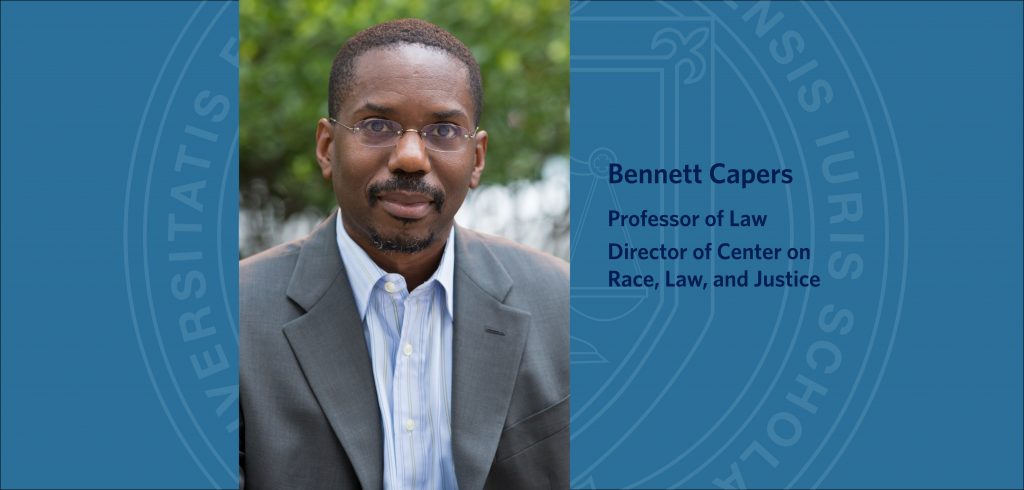“How could groundbreaking court opinions have been written had judges versed in critical race theory decided them?”
That is the fundamental question Professor Bennett Capers and other legal scholars look to answer in Critical Race Judgments: Rewritten U.S. Court Opinions on Race and Law (Cambridge University Press, April 2022). The book, co-edited by Capers, also aims to explain why critical race theory (CRT) should be deployed in various areas of the law to uphold and advance principles that are foundational to American democracy.
To celebrate the launch of the book, Professor Capers discussed the inspiration behind Critical Race Judgements and why it is incredibly unique at this time in history, to think about law through a CRT lens.
Why publish this book now?
This book was years in the making—seven years to be precise. But, in a way, the book couldn’t seem more timely, especially given the contentious confirmation hearing of Supreme Court nominee Judge Ketanji Brown Jackson and Senator Ted Cruz’s questions about whether CRT might influence Jackson’s decisions on the bench. She made clear it would not. “It doesn’t come up in my work as a judge. It’s never something that I studied or relied on and it wouldn’t be something I would rely on if I was on the Supreme Court,” Jackson told the Senate Judiciary Committee on March 22. But the hoopla over CRT does raise the question of what a CRT-based jurisprudence might look like. And that’s precisely the question our book seeks to answer.
What gave you the inspiration to launch this project?
I got the idea after learning about the Feminist Judgments book series, which imagines how important decisions would have come out had they been authored by feminists. I thought it would be interesting to ask a similar question using CRT. Since a publisher loved the idea, I immediately reached out to three of my favorite CRT scholars to see if they’d be interested in co-editing this book with me. Luckily, they said yes. And, after seven years, this is the result. So the heart of the book is a “what if?” question. As we put it in the introduction, “How might seminal Supreme Court opinions—and a few lower court cases—have come out (or been reasoned) differently had a Justice open to CRT been on the bench and been able to garner a majority of the vote?”
How did you and your co-editors (Devon Carbado of UCLA School of Law, Robin Lenhardt of Georgetown University Law Center and former faculty director of Fordham Law’s Center on Race, Law and Justice, and Dean Angela Onwuachi-Willig of Boston University School of Law) select which court opinions to include?
Part of the pleasure, for me, was working with my co-editors. The other pleasure was working with the amazing CRT scholars from around the country who we solicited to re-imagine and re-write Supreme Court opinions. We ended up including nearly 40 opinions, ranging from Plessy v. Ferguson (1896) and the Slaughter-House Cases (1873)to cases like Korematsu v. United States (1944), Loving v. Virginia (1967), Adoptive Couple v. Baby Girl (2013), and—of course—Brown v. Board of Education (1954). It was important to include important cases, and also cases that went beyond the black-white binary. We also wanted to include cases that, on their face, may not seem to touch on race at all, but of course do, such as Muller v. Oregon (1908), Roe v. Wade (1973), and Lawrence v. Texas (2003).
What editorial decisions did you and your co-editors make to strengthen the book’s arguments and bring cohesion to all of the essays included?
One of the many things that makes the book stand out for me—in addition to including a who’s who among CRT scholars—is the unusual structure of the book. Too often the traditional doctrinal way of organizing cases artificially compartmentalizes the nature of racial inequality and masks its intersecting dimensions of power. We decided to take a different approach to show how interconnected and overlapping racial issues are.
To that end, we organized the book around five thematic clusters—Membership and Inclusion; Participation and Access; Property and Space; Intimate Choice and Autonomy; and Justice—that address issues such as the death penalty, employment, voting, policing, education, the environment, justice, housing, immigration, sexual orientation, segregation, and mass incarceration. As we wrote in the introduction:
Our employment of these themes means that, from a conventional doctrinal approach, some of the cases may appear to be ‘out of place.’ That experience of disruption is one of our pedagogical goals—to encourage the reader to understand that where and whether a case is situated within the broad architecture of ‘race and the law’ is contingent on how racial inequality is imagined and what we view as appropriate remediation.
In the end, we hope these rewritten cases will show readers the difference a CRT approach could have made to decisions that affect us all, and the difference CRT can make still.

